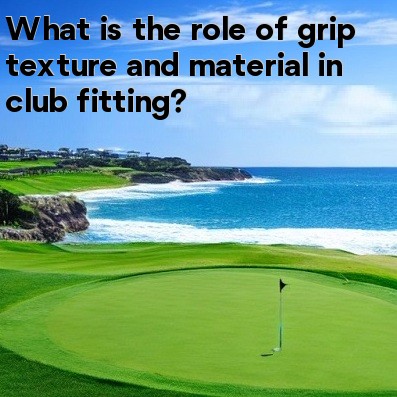
Grip texture and material are essential factors to consider in club fitting in golf. The grip is the only contact point between the golfer and the club, making it crucial for both comfort and control during the swing. Let's take a closer look at the role of grip texture and material in club fitting.
Texture
The texture of a golf grip refers to its surface pattern or patterned design. Different textures provide varying levels of traction and feel. Golfers often have personal preferences when it comes to grip texture, as it can significantly affect their grip pressure and overall confidence in their swing.
- Smooth: Smooth grips have a slippery surface, providing less friction between the hands and the grip. They can be ideal for golfers with lighter grip pressure, as they allow for easy hand movement during the swing. However, golfers who tend to have sweaty hands might struggle with a smooth grip as it could become slippery.
- Corded: Corded grips feature a rough texture with small cords or abrasive material embedded within the grip's surface. This texture offers excellent traction and is often used by golfers who prefer a firm grip. Corded grips are especially popular in wet conditions or for players with a tendency to have sweaty hands.
- Rubber: Rubber grips typically have a smooth or moderately textured surface, providing a balanced amount of traction. They are widely used and offer good comfort and durability.
- Wrap: Wrap grips have a unique pattern and design that provides a soft and cushioned feel. They often have a tacky surface, offering excellent grip security. Wrap grips are favored by golfers who prefer a more comfortable and shock-absorbing grip.
Material
The material of a golf grip influences its durability, feel, and responsiveness. There are various grip materials available in the market, each with its own set of characteristics.
- Rubber: Rubber grips are the most common type of grip material used in golf. They offer good durability, reasonable cost, and a wide range of texture options. Rubber grips also provide a solid and comfortable feel, making them suitable for many golfers.
- Composite: Composite grips combine multiple materials to offer improved performance. They often feature a soft rubber outer layer combined with a firmer inner core. This construction enhances both feel and responsiveness, providing golfers with a more controlled grip.
- Leather: Leather grips provide an old-school, classic charm to golf clubs. They offer a tacky feel and good moisture absorption, resulting in enhanced grip security. However, leather grips require more maintenance and may wear out faster compared to rubber or composite grips.
- Synthetic: Synthetic grips are made from materials like thermoplastic elastomers (TPE) or thermoplastic polyurethane (TPU). They offer a combination of durability, comfort, and all-weather performance. Synthetic grips are often designed to mimic the feel and responsiveness of traditional rubber grips.
When getting fitted for golf clubs, trying out different grip textures and materials can help determine the most suitable options for your preferences and playing conditions. It is advisable to consult with a professional club fitter who can assess your swing and provide recommendations based on your needs.





